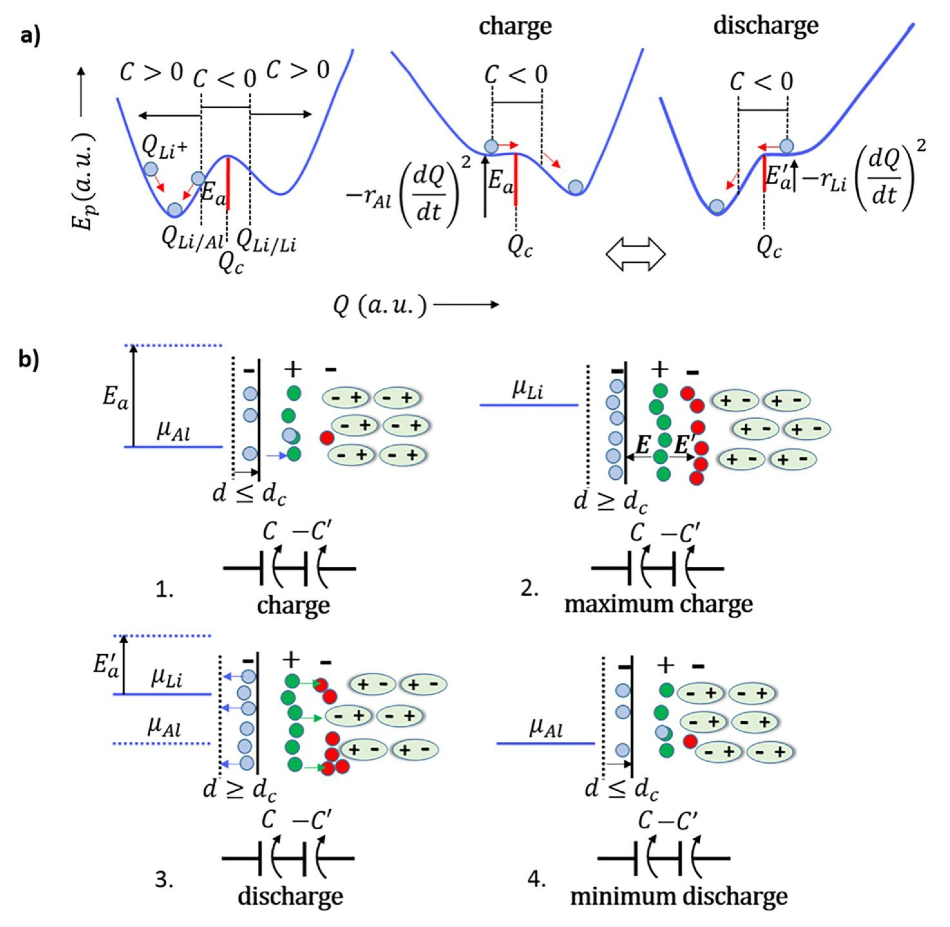Feb 26 2020
Researchers have designed a new kind of battery that integrates negative resistance and negative capacitance within a single cell. This feature allows the cell to self-charge without any energy loss, with significant implications for increased output power and long-term storage for batteries.
 Bistable energy landscape for a lithium-glass ferroelectric-electrolyte in contact with an aluminum-negative electrode and self-cycling process in an electrochemical aluminum/lithium glass/copper cell. (a) Variation of the potential energy with plated lithium leading to negative capacitance/self-charge and negative resistance/self-cycling. (b) Self-charge and self-cycling processes upon alignment of the dipoles in the ferroelectric-electrolyte due to the electrical necessity of aligning the Fermi levels. Image Credit: Braga et al.
Bistable energy landscape for a lithium-glass ferroelectric-electrolyte in contact with an aluminum-negative electrode and self-cycling process in an electrochemical aluminum/lithium glass/copper cell. (a) Variation of the potential energy with plated lithium leading to negative capacitance/self-charge and negative resistance/self-cycling. (b) Self-charge and self-cycling processes upon alignment of the dipoles in the ferroelectric-electrolyte due to the electrical necessity of aligning the Fermi levels. Image Credit: Braga et al.
Batteries of this kind can be used in very low-frequency communications and in devices like voltage-controlled oscillators, blinking lights, switching power supplies, electronic beepers, inverters, function generators, digital converters, and lastly, for technologies associated with modern computers.
In Applied Physics Reviews, published by AIP Publishing, Helena Braga and her team from the University of Porto in Portugal and the University of Texas at Austin have described how they developed their very simple battery using two different metals as electrodes and a lithium or sodium glass electrolyte between them.
The glass electrolyte we developed was lithium-rich, and so I thought that we could make a battery in which the electrolyte would feed both electrodes with lithium ions, on charge and discharge with no need for lithium metal.
Helena Braga, Researcher, University of Porto
This study is crucial as it combines the theory underlying all solid-state devices, such as capacitors, batteries, transistors, and photovoltaics, where various materials in electrical contact display the properties of the combined material rather than those of the individual materials.
When one of the materials is an insulator or dielectric, such as an electrolyte, it will locally change its composition to form capacitors that can store energy and align the Fermi levels within the device.
Helena Braga, Researcher, University of Porto
The open circuit potential difference between electrodes in a battery is caused by an electrical urge to align the Fermi levels, which is the quantity of energy of the least tightly held electrons inside a solid, which also governs the polarity of the electrodes. The chemical reactions play a role later and are induced by this electrical potential energy, which is stored in the capacitors.
“Our electrochemical cells, which in principle are simpler than batteries, are all about self-organization, which is the substance of life,” added Braga.
A more sustainable world can be ensured by mitigating or stopping self-cycling by preventing a leap in the Fermi levels or by configuring the occurrence of negative resistance.
“This can be obtained by having the negative electrode of the same material as the positive ions of the electrolyte,” stated Braga.
It gives rise to a device that self-charges without self-cycling—increasing the energy stored in it—as opposed to the natural degradation of the electrochemical process that makes the energy stored decrease by dissipation of heat. The latter has applications in all energy storage devices, such as batteries and capacitors, and can substantially improve their autonomy.
Helena Braga, Researcher, University of Porto